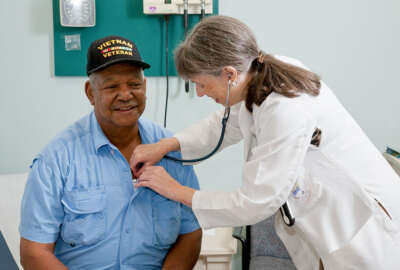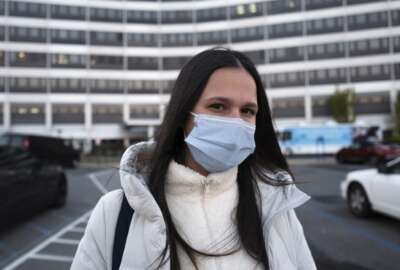
Telework capacity quadruples during pandemic, VA says
A four-fold increase in telework capacity, as well as a new chat bot and data visualization tool, are all helping the Department of Veterans Affairs respond to the...
To juggle multiple missions as a provider for veterans and the nation’s backup health system during a pandemic, the Department of Veterans Affairs has come to rely on tools both old and new.
Telework and telehealth aren’t new phenomena at VA, but the challenges of the pandemic forced VA to quadruple its remote work capacity in the last two months.
VA networks had the capacity to support 120,000 remote users in February before the pandemic to 240,000 to date, said Charles Worthington, chief technology officer for the department.
The department’s systems now have the capacity to support some 500,000 remote users if necessary, he said.
“These are not new concepts for the VA,” Worthington said Thursday during an ACT-IAC webinar. “Really what’s changed is just the number of people who were trying to flow through those systems. We’re lucky that we were building from an infrastructure that already existed and were trying to quickly ramp it up and improve it, as opposed to trying new things. We’re also experimenting with new ways to enable telework that are leveraging some of the latest and greatest from the cloud vendors and the new flexibilities with the TIC 3.0 policy.”
VA medical professionals are also conducting significantly more telehealth appointments using its video platforms. Before the pandemic, VA facilitated some 2,800 video connections for about 250,000 minutes a day.
Today, the department is conducting 22,000 video appointments for a total of 2 million minutes daily. Worthington said VA had to quickly improve and increase its network bandwidth to accommodate the massive increase in telehealth demand.
“To make that work it’s everything from just literally provisioning new circuits at our gateways [and] making sure that laptops are deployed with the latest patches to training our users who are not used to working remotely how to get on,” Worthington said. “IT has had to pull all that together to support this pretty unprecedented surge of use of these tools in a way that’s working effectively. ”
A coronavirus chat-bot, which VA launched in about three weeks, is a new addition to the department’s toolkit.
The chat bot helps veterans navigate common questions about VA’s coronavirus response, freeing up the phone lines for veterans who need to reach a medical professional for immediate help, Worthington said. Using plain language, the bot describes, for example, what kind of screening policies veterans might expect should they need to visit a VA facility.
“What we found, especially early in the crisis, there was a big surge of calls to our contact center,” he said. “The situation was changing pretty frequently, [such as] new instructions for what veterans who have appointments with VA… should do.”
A peek behind VA’s public-facing coronavirus data
In addition to the chat-bot, the department also launched a new data visualization tool to give VA decision-makers a common look at staffing, capacity and supplies across the health enterprise.
The national surveillance tool (NST) pulls in information from a variety of VA data sources, such as the department’s time and attendance and payroll systems, into one dashboard. The department built the platform using Microsoft Power BI, and the tool gives hospitals and facilities a single, authoritative look at VA data.
Having a common coronavirus data source breaks new ground for VA, where standardization hasn’t necessarily been the department’s strong suit, said Joe Francis, chief improvement and analytics officer at the Veterans Health Administration.
A single data repository for coronavirus information is also especially important during this pandemic, as the definitions of a ventilator or a positive or negative test can change quickly and without much notice.
“In a rapidly evolving situation as new technology or new definitions evolve, we don’t have time to update 18 or 130 different platforms,” Francis said. “It has to be in a single place.”
The NST gives VA decision-makers a look at multiple sources of information, including the number of available beds, ventilators, personal protective equipment and staff.
“We can keep track cumulatively where our veterans went, whether they’re in the ICU or they’re simply outpatients, what was their age distribution and what was their length of stay,” Francis said. “Again, [it’s] important for planning for the next day and the next week.”
As of mid-April, the national surveillance tool serves as the authoritative source for coronavirus data and information for the entire department.
VA leadership can segregate the information depending on the user. There’s a version of the NST, for example, specifically for high-level VA decision-makers, but there’s also a view for VA’s federal partners. The NST and its data also serves as the backbone to the COVID-19 national summary tool, designed as an information source for the public and the media.
It’s meant to be a living document that the department updates continuously. Data detailing the number of patients and facility capacity are updated hourly, while other data points get less frequent changes, Francis said.
The Food and Drug Administration and the Centers for Disease Control and Prevention have expressed interest in the tool, Francis said.
“It’s not specific to COVID. This is really a national surveillance tool,” he said. “That means if we had a different type o f national event, say a natural disaster — our fourth mission extends to things like hurricane and flood relief and earthquakes — the configuration here and the design allows us to be flexible to changing needs of health care.”
Copyright © 2024 Federal News Network. All rights reserved. This website is not intended for users located within the European Economic Area.
Nicole Ogrysko is a reporter for Federal News Network focusing on the federal workforce and federal pay and benefits.
Follow @nogryskoWFED
Related Stories





